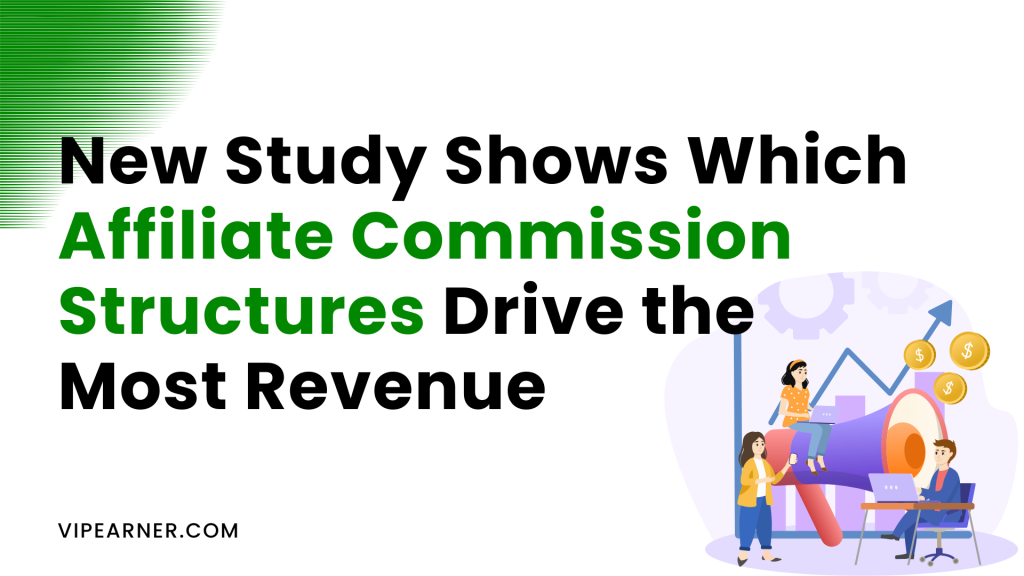AgentOps helps developers see inside their AI agents by logging every prompt, action, and cost. This review explains how it works, its features, setup, and why it’s becoming the go-to debugging tool for AI developers.
New Study Shows Which Affiliate Commission Structures Drive the Most Revenue

Affiliate marketing can be a lucrative way to earn money online, but understanding how you get paid is crucial. Commission structures are the backbone of affiliate programs, determining how much you earn for your efforts. Before diving into specific types, it's essential to grasp the basics.
Commission structures are essentially the payment models companies use to compensate affiliates for driving sales or leads. Think of them as your "paycheck formula" for affiliate work. Each structure has its own set of rules, advantages, and potential drawbacks.
When evaluating affiliate programs, always ask yourself these three key questions:
- "How much will I earn per sale?"
- "When do I get paid?"
- "What's the catch?"
Understanding the answers to these questions will help you choose programs that align with your goals and audience. Remember, the best commission structure for you depends on factors like your niche, traffic volume, and long-term strategy.
The 5 Main Commission Types (Simplified)

In the world of affiliate marketing, there are several common commission structures. Each has its own strengths and is suited to different types of products or services. Let's break down the five main types you're likely to encounter:
1. Percentage of Sale
This is perhaps the most straightforward commission structure. Here's how it works:
- You earn a fixed percentage of the product's price for each sale you generate.
- For example, if you're promoting a $100 product with a 10% commission rate, you'll earn $10 per sale.
Percentage-based commissions are best for:
- Expensive products or services (e.g., high-end electronics, luxury items)
- Digital products with high profit margins (e.g., online courses, software)
- Subscriptions, where you can earn a recurring percentage
However, be cautious with:
- Low-priced items, as your earnings per sale may be minimal
- Products with high return rates, as you might lose commissions on refunds
Pro Tip: Aim for products where a 10% commission equals at least $20 per sale. Always check the average order value before joining a program.
2. Flat Fee Per Sale
Flat fee commissions offer a fixed amount for each sale or lead, regardless of the product's price. Here's the breakdown:
- You receive a set dollar amount for every successful referral.
- For instance, you might earn $50 for each new insurance policy sign-up you generate.
This structure works well for:
- Inexpensive products where a percentage would yield little profit
- Service-based businesses (e.g., $30 for each new phone plan activation)
- Lead generation campaigns where the final sale value is unknown
Watch out for:
- Programs that frequently change their rates without notice
- Highly competitive niches where many affiliates promote the same flat-fee offer
Real-World Examples:
- Bluehost offers $65 to $130 per hosting sign-up
- Uber has paid $5 to $20 for new driver referrals
3. Tiered Commissions (Level Up!)
Tiered commission structures reward high-performing affiliates with increased rates as they hit certain sales targets. Here's how they typically work:
- Commission rates increase as you reach higher sales volumes
- For example:
- 0-10 sales: 10% commission
- 11-50 sales: 15% commission
- 50+ sales: 20% commission
This model is ideal for:
- Full-time affiliates who can drive significant traffic
- Marketers with loyal, engaged audiences
- Products with repeat customers or high purchase frequency
Pro Strategy: Combine tiered programs with email marketing. A list of 500 engaged subscribers could help you reach higher tiers consistently, boosting your earnings.
4. Recurring Commissions
Recurring commissions are the holy grail for many affiliates, offering ongoing income from a single referral. Here's the concept:
- You earn a percentage of the customer's recurring payments for as long as they remain a customer.
- For instance, if you refer someone to a $100/month software subscription with a 20% recurring commission, you'd earn $20 every month they stay subscribed.
This structure is perfect for:
- Building a stable, passive income stream
- Promoting SaaS products or services with long customer lifetimes
- Affiliates focused on long-term earnings over quick wins
Top Programs with Recurring Commissions:
- ConvertKit offers a 30% recurring commission on their email marketing platform
- Surfshark VPN provides 100% of the first payment plus 40% recurring thereafter
5. Hybrid Models
Hybrid commission structures combine elements from different models to create a unique payment system. They often look like this:
- A mix of flat fees and percentages, or one-time and recurring payments
- For example, you might receive a $50 signup bonus plus 5% of all future sales
You'll commonly find hybrid models in:
- Banking and fintech (e.g., $10 for account opening + 1% of deposits)
- Online marketplaces (e.g., $5 per new listing + 2% of sale price)
While hybrid models can be lucrative, be wary of:
- Overly complicated terms that make earnings hard to predict
- Hidden caps or limits (e.g., "Maximum $500 per month in bonuses")
How to Choose Your Best Commission Structure

Selecting the right commission structure is crucial for your success as an affiliate. Your choice should align with your experience level, niche, and marketing strategy. Let's look at recommendations for different stages of your affiliate journey:
For Beginners:
When you're just starting out, simplicity and quick wins are key. Focus on:
- Flat fee offers for products under $50
- Percentage commissions on physical goods (which typically have lower return rates)
Here's a suggested path for newcomers:
- Start by promoting 3-5 flat fee offers that pay $20-50 per sale
- Use your initial earnings to invest in building a website or growing an email list
- As your audience grows, transition to recurring percentage models for steady income
For Intermediate Affiliates:
As you gain experience and build a following, you can explore more complex structures:
- Look for tiered programs in your niche to reward your growing influence
- Focus on recurring SaaS subscriptions for building long-term income
A proven combination for intermediate affiliates includes:
- One high-ticket percentage item (products $500 or more)
- One recurring service commission (aim for products around $50/month or higher)
- Two to three reliable flat fee offers for consistent cash flow
Advanced Strategy:

Experienced affiliates with significant traffic or a highly engaged niche audience can often negotiate custom terms. Don't be afraid to ask for:
- Higher percentage rates if you consistently drive 1,000+ monthly visitors
- Custom bonuses (e.g., $500 extra for hitting 50 sales in a month)
- Faster payout terms (such as 7 days instead of the standard 30)
Here's a template you can use to start the conversation:
"Hi [Merchant Name],
My audience has consistently purchased [X number] of similar products in your niche. I believe I can drive significant sales to your program. Would you be open to discussing custom commission terms for affiliates who can deliver 50+ sales per month?"
Remember, the worst they can say is no, and many programs are willing to create special arrangements for top-performing affiliates. (some platforms already have specific milestones in place where top affiliates can make extra commissions)
Red Flags to Avoid

While many affiliate programs are legitimate and beneficial, some red flags should make you think twice before joining. Here are key warning signs to watch for:
- "Unlimited Earnings" Claims
When a program boasts about unlimited earning potential, it often means:- Few affiliates are making significant money
- The offer might be a scam or pyramid scheme
Always research thoroughly and look for concrete evidence of earnings.
- Delayed Payments
Be cautious of programs that hold your funds for extended periods. Avoid those that:- Delay payments for more than 45 days without good reason
- Have a history of late or missed payments reported by other affiliates
- Hidden Terms
Always read the fine print. Watch out for clauses like:- "Commission only on first purchase" (no recurring earnings)
- "Exclusions apply" without clear explanations
- Complicated rules that make it hard to understand when you'll get paid
Tools to Track Your Commissions
Proper tracking is essential for optimizing your affiliate efforts. Here are some tools to consider:
| Tool | Best For | Cost | Key Features |
|---|---|---|---|
| Pretty Links | Beginners | Free | Easy link cloaking, basic click tracking |
| ClickMagick | Advanced tracking | $37/mo | Detailed analytics, split testing |
| HubSpot | CRM + commissions | Free-$800 | Full marketing suite, advanced reporting |
| Google Sheets | DIY tracking | Free | Customizable, manual data entry |
Choose a tool that matches your technical skill level and the complexity of your affiliate operations. As you grow, you may need to upgrade to more sophisticated tracking solutions.
3-Step Action Plan
To optimize your affiliate earnings, follow this simple action plan:
- Audit Your Current Programs
- List all the affiliate programs you're currently part of
- Calculate your effective hourly rate: (Monthly earnings) ÷ (Hours spent promoting)
This will show you which programs are worth your time and effort.
- Replace Underperformers
- Identify and remove programs paying less than $20 per hour of effort
- Research and add 1-2 high-commission offers in your niche to replace them
Focus on quality over quantity to maximize your earnings.
- Automate Tracking
- Set up real-time dashboards using your chosen tracking tool
- Schedule a weekly review every Sunday to analyze your performance
Consistent monitoring will help you make data-driven decisions about which programs to promote.
The Simple Truth About Commissions
After exploring various commission structures, here's the bottom line for most affiliates:
Best programs for sustainable income:
- Recurring percentage commissions: These build long-term wealth and provide passive income.
- Tiered programs with bonuses: They reward your hard work and incentivize growth.
Worst picks for beginners:
- Low percentages on cheap products: These often result in earnings of just $1-5 per sale.
- "Exclusive" programs with no proven track record: Be wary of new programs making big promises.
Final Tip: Always match your commission structure to your current audience size and engagement level. Start with simple flat fees, grow into recurring models, and then leverage your success to negotiate custom deals once you have a substantial following (typically 1,000+ engaged subscribers or consistent traffic).
Remember, the key to affiliate success is not just choosing the right commission structure, but also providing genuine value to your audience. Focus on promoting products you believe in, and the earnings will follow.
Additional Factors Influencing Affiliate Earnings

When evaluating affiliate programs, it's crucial to look beyond the basic commission rates. Several other factors can significantly impact your earning potential and the overall value of a program. Let's explore these important aspects:
1. Cookie Duration: The Lifespan of Your Referral
Cookie duration refers to how long a tracking cookie remains active after a user clicks your affiliate link. This timeframe is critical because it determines how long you can earn a commission from a referred customer.
- Short Cookie Duration (1-7 days): Common in highly competitive niches or for impulse-buy products.
- Medium Cookie Duration (30 days): Standard for many affiliate programs.
- Long Cookie Duration (90+ days): Ideal for affiliates, especially for products with longer sales cycles.
Pro Tip: Look for programs offering at least a 30-day cookie duration. For big-ticket items or B2B products, aim for 60-90 days to capture more conversions.
2. Minimum Payout Thresholds: When You Get Paid
Most affiliate programs set a minimum earnings threshold before you can request payment. This is important to consider, especially when you're starting out.
- Low Threshold ($20-$50): Great for beginners or low-volume affiliates.
- Medium Threshold ($100-$500): Common among established programs.
- High Threshold ($1000+): Typically seen in high-ticket or B2B programs.
Strategy: Balance programs with different thresholds. While lower thresholds provide quicker access to earnings, higher thresholds in lucrative niches can lead to larger payouts.
3. Performance-Based Commissions: Incentivizing Success
Performance-based commissions reward affiliates for achieving specific targets or milestones. This model encourages continuous improvement and high-quality traffic.
- Example: A program might offer a 10% commission for the first 10 sales, increasing to 15% for the next 20 sales, and 20% for any sales beyond that.
Benefits:
- Increased Earnings Potential: Higher commissions for better performance.
- Motivation: Incentivizes affiliates to optimize their marketing strategies.
- Quality Over Quantity: Encourages affiliates to focus on converting high-quality leads.
4. Time-Limited Commissions: Capitalizing on Seasonality
Time-limited commissions are often used to capitalize on seasonal demand or limited-time offers. These structures can significantly boost earnings during specific periods.
- Example: A summer clothing brand might offer a 20% commission for all sales made in June and July, compared to the standard 10% rate.
Strategy:
- Seasonal Promotions: Align your marketing efforts with seasonal demand.
- Limited-Time Offers: Create urgency with countdown timers or exclusive deals.
5. Product-Specific Commissions: Tailoring Incentives

Some programs offer different commission rates for different products or categories. This allows businesses to incentivize the promotion of specific items.
- Example: A tech company might offer a 15% commission on laptops but only 5% on accessories.
Benefits:
- Targeted Marketing: Focus on high-commission products to maximize earnings.
- Diversified Portfolio: Promote a mix of products to balance earnings across categories.
6. SaaS-Specific Structures: Recurring Revenue
For software-as-a-service (SaaS) products, recurring commissions based on customer lifetime value are common. These structures provide ongoing income for affiliates.
- Example: A SaaS company might offer a 30% recurring commission on subscription fees.
Benefits:
- Passive Income: Earn commissions as long as customers remain subscribed.
- Long-Term Value: Focus on promoting products with high customer retention rates.
7. Commission Caps: Understanding Limits
Some programs implement upper limits on commissions to protect their profit margins. Understanding these caps is crucial to avoid surprises.
- Example: A program might cap commissions at $500 per month, regardless of sales volume.
Strategy:
- Diversify Programs: Spread your efforts across multiple programs to avoid hitting caps.
- Negotiate Terms: If you consistently drive high sales, consider negotiating custom terms.
Comparison Table: Key Factors in Affiliate Programs
| Factor | Description | Impact on Affiliates |
|---|---|---|
| Cookie Duration | Length of time tracking cookies remain active. | Longer durations capture more conversions. |
| Minimum Payout Threshold | Minimum earnings required before payment. | Lower thresholds provide quicker access to earnings. |
| Performance-Based Commissions | Higher rates for achieving sales targets. | Incentivizes quality traffic and performance. |
| Time-Limited Commissions | Increased rates for limited-time offers. | Capitalizes on seasonal demand or promotions. |
| Product-Specific Commissions | Different rates for different products. | Allows targeted marketing of high-commission items. |
| SaaS-Specific Structures | Recurring commissions for subscription services. | Provides ongoing income for affiliates. |
| Commission Caps | Upper limits on earnings to protect profit margins. | Avoids surprises by understanding limits upfront. |
By considering these factors and understanding how they impact your earnings, you can make informed decisions about which affiliate programs to join and how to optimize your marketing strategies for maximum profit.

